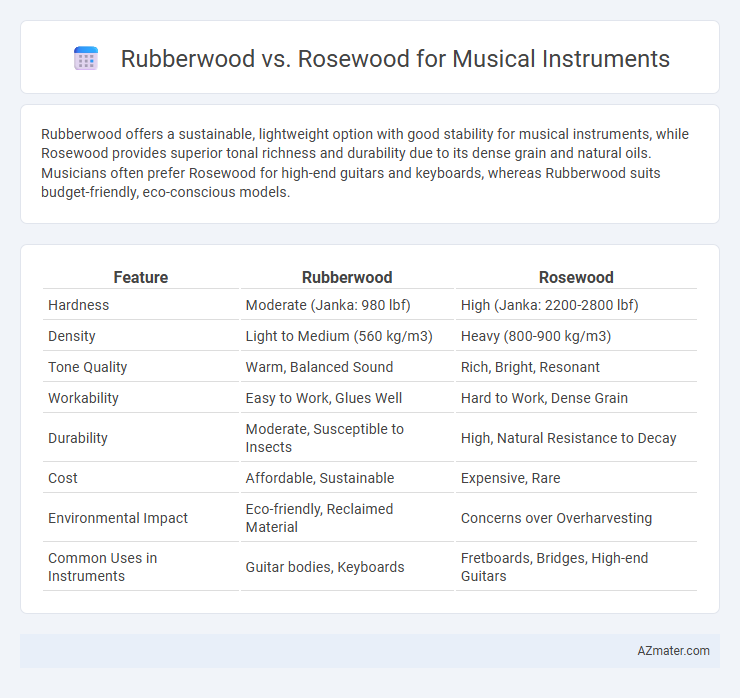Rubberwood offers a sustainable, lightweight option with good stability for musical instruments, while Rosewood provides superior tonal richness and durability due to its dense grain and natural oils. Musicians often prefer Rosewood for high-end guitars and keyboards, whereas Rubberwood suits budget-friendly, eco-conscious models.
Table of Comparison
| Feature | Rubberwood | Rosewood |
|---|---|---|
| Hardness | Moderate (Janka: 980 lbf) | High (Janka: 2200-2800 lbf) |
| Density | Light to Medium (560 kg/m3) | Heavy (800-900 kg/m3) |
| Tone Quality | Warm, Balanced Sound | Rich, Bright, Resonant |
| Workability | Easy to Work, Glues Well | Hard to Work, Dense Grain |
| Durability | Moderate, Susceptible to Insects | High, Natural Resistance to Decay |
| Cost | Affordable, Sustainable | Expensive, Rare |
| Environmental Impact | Eco-friendly, Reclaimed Material | Concerns over Overharvesting |
| Common Uses in Instruments | Guitar bodies, Keyboards | Fretboards, Bridges, High-end Guitars |
Introduction to Rubberwood and Rosewood in Musical Instruments
Rubberwood, sourced from the Para rubber tree, is prized for its sustainability and affordability in musical instrument manufacturing, particularly in acoustic guitars and percussion instruments. Rosewood, known for its rich tonal qualities and dense grain structure, remains a preferred choice for high-end guitar fretboards, backs, and sides due to its resonance and durability. Both woods influence instrument sound and playability, with Rosewood offering warmer tones and Rubberwood supporting eco-friendly production without sacrificing performance.
Botanical Origins and Characteristics
Rubberwood, derived from Hevea brasiliensis, is a sustainable hardwood known for its light color, moderate density, and consistent grain, commonly used in affordable musical instruments like guitar bodies and keyboards. Rosewood, primarily from Dalbergia species found in tropical regions, is prized for its rich color, dense structure, and natural oils, offering superior resonance and durability sought after in premium guitars, violins, and other string instruments. The botanical origins influence the acoustic properties, with rosewood's natural oils enhancing tonal warmth and projection, while rubberwood provides eco-friendly affordability without compromising structural stability.
Visual Appeal: Color, Grain, and Finish
Rubberwood offers a light, creamy color with subtle grain patterns, providing a smooth and uniform finish ideal for modern, minimalist instruments. Rosewood boasts rich, deep hues ranging from dark brown to purple, with pronounced grain lines and natural oils that enhance its glossy, luxurious finish. The distinct visual appeal of rosewood often makes it preferred for high-end instruments seeking warmth and elegance, while rubberwood suits budget-friendly options emphasizing clean aesthetics.
Sound Quality and Acoustic Properties
Rubberwood produces a warm, balanced tone with moderate resonance, making it suitable for entry-level guitars and ukuleles due to its affordability and sustainability. Rosewood offers superior acoustic properties with rich overtones, deep bass response, and excellent sustain, favored by professional musicians for high-end guitars and classical instruments. The dense grain structure of rosewood enhances projection and clarity, whereas rubberwood's softer composition results in less pronounced tonal complexity.
Durability and Longevity in Instrument Construction
Rubberwood offers moderate durability and resistance to wear, making it a budget-friendly option for musical instrument construction but less ideal for longevity compared to rosewood. Rosewood boasts exceptional hardness and density, contributing to superior durability and long-lasting performance in instruments such as guitars and pianos. The natural oils and tight grain structure of rosewood enhance its resistance to moisture and warping, ensuring stability and sustained tonal quality over decades.
Workability: Ease of Shaping and Finishing
Rubberwood offers excellent workability due to its uniform grain and moderate hardness, making it easy to shape and finish for musical instruments. Rosewood, while denser and harder, provides a smooth finish but requires more skill and sharper tools to shape accurately. Both woods yield quality results, though Rubberwood is preferred for beginners or mass production, whereas Rosewood suits expert luthiers seeking rich tonal qualities and intricate detailing.
Environmental Impact and Sustainability
Rubberwood, derived from the Para rubber tree (Hevea brasiliensis), is a sustainable option for musical instruments as it utilizes plantation trees harvested after latex production, reducing deforestation and promoting eco-friendly forestry practices. Rosewood, commonly sourced from Dalbergia species, faces severe environmental impact due to overharvesting and illegal logging, leading to habitat destruction and inclusion in CITES Appendices restricting trade. Choosing rubberwood supports renewable resource use with lower carbon footprints, while rosewood's scarcity and ecological consequences demand careful consideration for sustainable instrument manufacturing.
Cost Comparison for Luthiers and Musicians
Rubberwood offers a cost-effective alternative to rosewood, with prices generally 60-70% lower, making it attractive for budget-conscious luthiers and musicians. While rosewood provides superior tonal quality prized in high-end guitars, its scarcity and regulatory restrictions under CITES significantly increase its market value. Rubberwood's affordability and sustainable sourcing appeal to beginner and mid-range instrument makers seeking quality without the premium price tag.
Popular Musical Instruments Using Each Wood
Rubberwood, prized for its sustainability and affordability, is frequently used in the production of acoustic guitars, ukuleles, and cajons due to its balanced tone and durability. Rosewood, renowned for its rich acoustic properties and striking grain patterns, is commonly chosen for high-end guitar fretboards, violin fittings, and marimbas, enhancing both sound quality and aesthetic appeal. The distinct tonal warmth of rosewood contrasts with rubberwood's brighter sound, influencing instrument makers' material selections based on desired acoustic characteristics.
Choosing the Right Wood: Key Considerations for Musicians
Rubberwood offers a sustainable, affordable option with a light, balanced tone ideal for beginners and mid-range musical instruments, while rosewood provides rich, warm resonance favored in high-end guitars and pianos due to its dense grain structure. Musicians should consider factors such as tonal quality, durability, and environmental impact when selecting between these woods, as rosewood delivers superior sustain and projection but comes at a higher cost and stricter trade regulations. Understanding the sound characteristics and physical properties of rubberwood and rosewood ensures the right wood choice to enhance instrument performance and longevity.

Infographic: Rubberwood vs Rosewood for Musical Instrument
 azmater.com
azmater.com